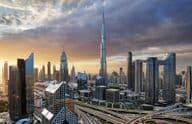UAE Weather Alerts: Extreme Heat and More

UAE Weather Alert: Extreme Heat, Dust Storm and Fog Warnings – What to Watch Out for in Summer?
The summer weather in the United Arab Emirates shows no mercy, and on August 15, 2025, it once again revealed its harsh face. According to forecasts from the National Center of Meteorology (NCM), on this Friday, temperatures in the interior could reach up to 48 °C, while in Dubai, they will fluctuate between 34 °C and 44 °C, and in Abu Dhabi between 33 °C and 47 °C during the day. This extreme weather affects not only comfort but also transportation, health, and daily activities.
Dust Storm and Reduced Visibility – Orange Alert in Several Regions
In the morning hours, the NCM issued a yellow warning due to dusty and windy weather, which was raised to orange in the afternoon, especially around Ras Al Khaimah International Airport. Horizontal visibility might drop to less than 2000 meters, posing a particular danger for transportation, be it driving or air travel.
The dust storms are caused by occasionally strengthening winds from the east and north, carrying sand and dust, reducing visibility, and complicating outdoor activities. Such weather conditions are particularly taxing for people with respiratory disorders, making it advisable to stay indoors during the most intense periods (between 8 a.m. and 5 p.m.).
Fog Warning in the Morning – Hazardous for Transit
In addition to dust storms, the NCM also warned about fog on Friday morning. The dense fog developing in the early hours can significantly impair visibility, especially on open roads and highways. Authorities urged residents to exercise caution and asked them to only set out if necessary and to drive slowly using fog lights.
Increasing Cloud Formation and Rising Temperatures in the Afternoon
According to the meteorological center, cumulus clouds are expected to develop in an easterly direction in the afternoon, with cloudy skies anticipated in the eastern and southern regions by evening. At the same time, temperatures might also rise. Despite the cloudiness, the chance of precipitation is minimal, but the cloud cover may further increase humidity, making the heat feel even more oppressive.
Marine Conditions – Moderate Waves but Changing Conditions
The meteorological forecast predicts moderate sea conditions along the Persian Gulf, though it may become stormy in offshore areas at times. Light to moderate waves are expected along the Oman Sea coast. Those planning marine sports or navigation should keep a keen eye on current marine reports, as the changing weather can quickly alter what might initially seem safe conditions.
Extreme Heat – How to Prepare?
In several regions of the country, temperatures have surpassed 45 °C, with the highest reading recorded on Thursday afternoon at 48.5 °C in the Al Dhafra region. This heat is not just uncomfortable but can also be hazardous, especially for the elderly, children, and those with chronic health conditions.
What Can Be Done Against the Heat?
Avoid outdoor activities between 11 a.m. and 5 p.m.
Drink plenty of water and avoid caffeinated beverages.
Wear light, loose clothing, and use sunscreen.
Cool your body with frequent showers.
Do not leave children or pets in parked cars.
Use UV-filtered sunglasses and hats.
Impact of Summer Weather on Daily Life
The heat and dust storms cause not just inconveniences but also have economic and social impacts. Construction projects often face delays due to occupational safety regulations that prohibit outdoor work during certain hours. Traffic jams might increase, as many prefer to set out in the early morning or late evening to avoid daytime heat.
Tourism also reacts sensitively to heatwaves – while indoor attractions (e.g., malls, aquariums, museums) see increased attendance, the demand for desert tours and outdoor programs declines. Service providers often temporarily halt outdoor offerings or adjust their opening hours.
Summary
The current weather situation clearly shows that UAE’s summer climate poses significant challenges for both residents and visitors. The combination of heat, dust storms, and fog requires heightened caution, particularly in transportation and health preservation. It is advisable to continuously follow NCM warnings and adapt to changing conditions.
With proper preparation, however, these periods can be weathered, and serious health or safety issues can be avoided with due care. Those who can, should favor cool, air-conditioned environments for work, rest, or transit.
(Source of the article is the National Center of Meteorology announcement.)
If you find any errors on this page, please let us know via email.


